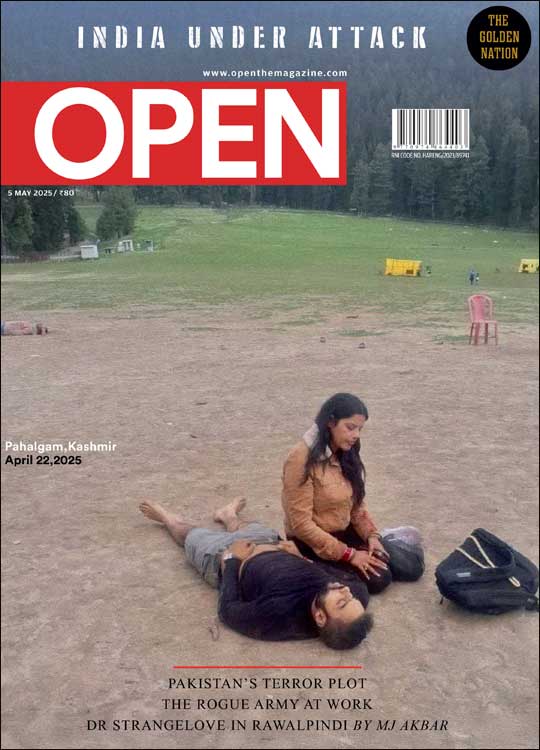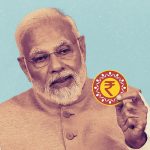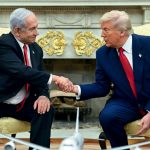Beyond Kashmir
India’s problem with Pakistan is the nature of the beast itself
 Shashi Tharoor
Shashi Tharoor
 Shashi Tharoor
Shashi Tharoor
 |
23 Aug, 2018
|
23 Aug, 2018
/wp-content/uploads/2018/08/Beyondkashmir1.jpg)
WHEN PAKISTAN WAS created in 1947, its founder Muhammad Ali Jinnah publicly expressed the hope (and the expectation) that its relations with India would come to resemble those between Canada and the US. His idea was of two countries with more in common than not—separate politically but united culturally, and linked by strong economic ties and close human relationships. As we all know, that was not to be. Today, 71 years later, with a cricket hero the newly anointed prime minister of Pakistan, how should we look back at this relationship, and look forward to the uncertain future?
Pakistan was hacked off the stooped shoulders of India by the departing British in 1947 as a homeland for India’s Muslims, but—at least until very recently, if one can extrapolate from the two countries’ population growth trends—more Muslims have remained in India than live in Pakistan. Pakistan’s relations with India have ever since been bedevilled by a festering dispute over the divided territory of Kashmir, India’s only Muslim-majority state. Decades of open conflict and simmering hostility, punctuated by spasms of bonhomie that always seem to sputter out into recrimination, have characterised a relationship that has circumscribed India’s options and affected its strategic choices. The knowledge that our nearest neighbour, populated as it is by a people of a broadly similar ethnic mix and cultural heritage, defines itself in opposition to India and exercises its diplomatic and military energies principally to thwart and undermine us, has inevitably coloured India’s actions and calculations on the regional and global stage. The resort by Pakistan to the sponsorship of militancy and terrorism within India as an instrument of state policy since the 1980s has made relations nearly as bad as in the immediate aftermath of independence.
There is, in Indian eyes, a deep-seated pathology at work here. Former Pakistani Ambassador Husain Haqqani has written of ‘Pakistan’s near pathological obsession with India’ and the ‘paranoia’ of its elite, fuelled by the resentment of émigrés from India who developed ‘a national narrative of grievance’. These migrants, who did not hail from the territory of the country they were ruling, had to develop and sustain an ideological narrative about Pakistan, giving birth to a nationalism that was reductive: Pakistan’s principal raison d’être became that it was not India and that it defined its interests in opposition to India’s.
The ‘two-nation theory’ that Hindus and Muslims could not live together, and the notion of a thousand years of conflict between the two peoples, had to be created, justified and propagated, including through the ‘prescribed myths’ of tendentious history textbooks. As the Pakistani commentator Khaled Ahmed observed: ‘Pakistani nationalism comprises 95% India-hatred. They call it Islam because that is how we learn to differentiate between ourselves and India.’ Islam became central to Pakistan’s sense of itself: as the academic Waheed- uz-Zaman put it in 1973, ‘If the Arabs, the Turks, the Iranians, God forbid, give up Islam, the Arabs yet remain Arabs, the Turks remain Turks, the Iranians remain Iranians, but what do we remain if we give up Islam?’ One Pakistani official answered this question to the New York Times in 1980: ‘second-rate Indians’.
If this visceral hatred of India is, to Pakistanis, the main casus belli, embellished by the ‘just cause’ of Kashmir, the horrors that were inflicted on Mumbai by terrorists from Pakistan at the end of November 2008 remain the starting point for any Indian’s discussion of Pakistan. They have left an abiding impact on all Indians. India picked itself up after the assault, but it counted the cost in lives lost, property destroyed and, most of all, in the scarred psyche of a ravaged nation. Deep and sustained anger across the country—at its demonstrated vulnerability to terror and at the multiple institutional failures that allowed such loss of life— prompted the immediate resignations of the Home Minister in Delhi and the Chief Minister and his deputy in Maharashtra. But ‘26/11’ in Mumbai represented a qualitative change in Pakistan’s long-running attempts to pursue ‘war by other means’. The assault, and the possibility of its recurrence, implied that there could be other consequences, yet to be measured, that the world will have to come to terms with in the future—consequences whose impact could extend well beyond India’s borders, with implications for the peace and security of the region, and the world.
After the killings, platitudes flowed like blood. Terrorism is unacceptable; terrorists are cowards; the world stands united in unreserved condemnation of this latest atrocity, and so mind-numbingly on. Commentators in America tripped over themselves to pronounce the night and day of carnage ‘India’s 9/11’. But India has endured many attempted 9/11s, notably a ferocious assault on its Parliament in December 2001 that nearly led to all-out war against the assailants’ sponsors, Pakistan, and continuing into a series of assaults on Indian installations in 2017. In 2008 alone, terrorist bombs had taken lives in Jaipur, Ahmedabad, Delhi and (in an eerie dress rehearsal for the effectiveness of synchronicity) several different places on one searing day in Assam. Mumbai, however, combined all the four elements of its precursors: by attacking it, terrorists hit India’s economy, its tourism and its internationalism, and they took advantage of the city’s openness to the world. So the terrorists hit multiple targets in Mumbai, both literally and figuratively. They caused death and destruction to our country, searing India’s psyche, showing up the limitations of its security apparatus and humiliating its government. They dented the worldwide image of India as an emerging economic giant, a success story of the era of globalisation and an increasing magnet for investors and tourists. Instead, the world was made to see an insecure and vulnerable India, a ‘soft state’ besieged by enemies who could strike it at will.
This has been the fate of successive governments in India. Prime Minister Vajpayee’s extraordinary overland visit to Lahore in 1999, his historic speech at the Minar-e-Pakistan repudiating his earlier hawkish views, and the signing of the Lahore Declaration were followed within months by the Pakistani incursion into Kargil. While to his credit, Prime Minister Narendra Modi made attempts to reach out to his Pakistani counterpart Nawaz Sharif—particularly with the invitation to Modi’s inauguration in May 2014, and the subsequent impromptu trip to Pakistan on the occasion of Sharif’s birthday on Christmas Day 2016—this did not stop the Pakistani ‘deep state’ later sponsoring multiple attacks in Pathankot, Uri and Nagrota.
India responded in kind with what it called ‘surgical strikes’, precision attacks on terrorist camps operating on Pakistani soil (something which, as subsequently emerged, India has resorted to in the past without boasting about it). With the publicly announced strikes, India has made clear that inaction is not the only possible response to terrorist provocations.
It is a brave and slightly risky strategy, because it obliges India to pursue a similar course of action when the next significant terrorist strike occurs. Still, a country that refuses to suffer repeated body blows earns more respect than one whose restraint can be interpreted as weakness. If this determination, and Pakistan’s ensuing diplomatic isolation, prompts Pakistani generals to rethink their policy of sponsoring terrorism as an instrument of state policy, peace between the neighbours could once again become a possibility. But, for India, as subsequent attacks have demonstrated, such hopes have been betrayed too often in the recent past for it to continue to turn the other cheek.
No Pakistani leader has had the courage or the foolhardiness to confront the military’s stranglehold on power. There is no reason to believe Imran, heading a minority government, will be any different
For India, the central problem blighting the relationship between the two Subcontinental neighbours is not, as Pakistani propagandists like to suggest, Kashmir, but rather the nature of the Pakistani state itself—specifically, the stranglehold over Pakistan of the world’s most lavishly funded military (in terms of percentage of national resources and GDP consumed by any army on the planet). To paraphrase Voltaire on Prussia, in India, the state has an army; in Pakistan, the army has a state. Unlike in India, one does not join the army in Pakistan merely to defend the country; one joins the army to run the country. The military has ruled Pakistan directly for a majority of the years of its existence, and indirectly for most of the rest. Until 2013, no previous elected civilian government had been allowed to complete its full term; Zulfikar Ali Bhutto was an exception, but he was arrested (and later hanged) immediately after he completed his initial tenure. The army lays down the ‘red lines’ no civilian leader—and not even the ‘free’ media—dare cross.
For half the country’s existence, the military has ruled Pakistan directly after a series of coups; the rest of the time it has stayed in the shadows, controlling the elected civilian governments and calling the shots on foreign and security policy (especially vis à vis India) that no government dares challenge. Even civilian leaders with a popular base, like Zulfikar Ali Bhutto, bribed the military with generous allocations in the vain hope that this would forestall a coup against them. No Pakistani leader has had the courage, or the foolhardiness, to confront the military’s stranglehold on power. There is no reason to believe Imran Khan, heading a minority government, will be any different.
This situation goes back to the very founding of the country. At Partition, Pakistan received, thanks to the lopsided application of the ‘martial races’ theory by the British, a larger share of undivided India’s military than of either its population or territory. With 21 per cent of India’s population and 17 per cent of its revenue, Pakistan got 30 per cent of the Indian Army, 40 per cent of the Indian Navy and 20 per cent of the Indian Air Force, obliging its government to devote 75 per cent of the country’s first budget to cover the costs of maintaining this outsize force. The disproportionately large military establishment had a vested interest in its own perpetuation; as Haqqani points out, it ‘needed a threat if it was to be maintained’. Sadly, instead of cutting back on its commitments to the military, Pakistan kept feeding the monster till it devoured the country itself. Even when Pakistan lost half its territory in the disastrous Bangladesh War of 1971, the army continued to expand.
In return, the military establishment enjoys privileges unthinkable in India. In addition, serving and retired military officials run army-controlled shopping malls, petrol stations, real-estate ventures, import-export enterprises, and even universities and think-tanks. Since the only way to justify this disproportionate dominance of the Pakistani state and society is to preserve the myth of an ‘Indian threat’, the Pakistani military will, many in India believe, continue to want to keep the pot boiling, even if Kashmir were to be handed over to them on a silver salver with a white ribbon tied around it. In the analysis of the Pakistani commentator Cyril Almeida, the army is not strategically interested in peace; it may not want war (which General relishes dying?) but it does not want peace either.
From an international perspective, support for Pakistan from other countries has also dealt the country a great deck of cards. American backing for Pakistan as a Cold War ally absolved the country of the obligation to deal constructively with India—a practice continued till recent times (and the jury is still out on whether things will comprehensively change under Trump). More worryingly, China’s backing of Pakistan in multiple international forums, notably the Security Council and its Sanctions Committee, as well as its deep strategic economic commitment to Pakistan, has only strengthened as American commitment appears to be weakening. The China- Pakistan Economic Corridor (CPEC), which India justifiably argues undermines its sovereignty since it runs through territory in Pakistan-controlled Kashmir that China itself recognises as disputed, has been a significant cause of worry for New Delhi.
Similarly, Pakistan’s strategic choice of drawing closer to Arab West Asia accentuated the sense of inveterate Islamism within Pakistan, and brought petrodollars and fundamentalist interpretations of Islam into its prevailing ethos. Pakistani clerics and worse, official (and officially directed) mass media, evolved and assiduously reiterated the theory of the ‘Ghazwa-e- Hind Hadith’, under which the Prophet himself had predicted a ‘final battle’ in Hind before the End of Times. Jihadi groups were spawned, nurtured and indoctrinated with the belief that every one of their assaults on Indians was part of a Battle for India foreseen by Islam’s Prophet. But as Dr Frankenstein discovered when his monster escaped his control, such doctrines can bite their own creators; some jihadi groups, notably the Pakistani Tehreek-e-Taliban, realised that ‘Hind’ in the Prophet’s time included what is today Pakistan, and used the same Hadith to justify terrorist attacks on ‘godless’ installations of Pakistan’s military establishment in the name of Islam.
It will take credible action by Pakistan on two fronts to set things right: action to bring the conspirators and perpetrators of the 26/11 attack to justice, and action to begin dismantling the infrastructure of terrorism
On the other side, Indians have learned to endure the unspeakable horrors of terrorist violence ever since malign men in Pakistan concluded that it was cheaper and more effective to bleed India to death than to attempt to defeat it in conventional war. There had, after all, been four unsuccessful wars—the failed attempts by Pakistan in 1947-48 and 1965 to wrest control over Kashmir, the 1971 war that resulted in the birth of Bangladesh from the ruins of former East Pakistan and the undeclared Kargil war of 1999, in which Pakistani soldiers were dressed in mufti to conceal their identities when they surreptitiously seized the heights above Kargil in Kashmir, until being repelled in a heroic but costly action by the Indian Army. Attack after attack on Indian soil since then has been proven to have been financed, equipped and guided from across the border, including two suicide bombings of the Indian embassy in Kabul, the first of which was publicly traced by American intelligence to Islamabad’s dreaded military special-ops agency, the Inter-Services Intelligence (ISI), and its ‘Directorate S’ that collaborates with and directs terrorists and militants.
India’s response has been defensive, not belligerent. India is a status quo power that seeks nothing more than to be allowed to grow and develop in peace, free from the destructive attentions of the Pakistani military and the militants and terrorists it sponsors. Pakistan has sought to obscure this reality by seeking to convince the West and China that its militarism is in response to an ‘Indian threat’, a notion assiduously peddled in Washington and London by highly paid lobbyists for Islamabad. The rationale for this argument goes back to 1971, when India, in their version of the narrative, attacked and dismembered Pakistan. This action, it is suggested, reveals India’s intentions: it is simply waiting for an opportunity to do to what remains of Pakistan what it did to the country’s old political geography.
YET IT IS CLEAR that we want peace more than Pakistan does, because we have more at stake when peace is violated. To those who suggest that we should simply ignore our dysfunctional neighbours, accept the occasional terror blast (and prevent the ones we can), tell ourselves there is nothing we need from Pakistan and try to get on with our development free of the incubus of that benighted land, there is only one answer: we cannot grow and prosper without peace, and that is the one thing Pakistan can give us that we cannot do without. We cannot choose to be uninterested in Pakistan, because Pakistan is dangerously interested in us. By denying us the peace we crave, Pakistan can undermine our vital national interests, above all that of our own development. Investors shun war zones; traders are wary of markets that might explode at any time; tourists do not travel to hotels that might be terrorist targets. We should be aware of this too, and we should ensure they are aware that we are aware. And yet we must engage Pakistan because we cannot afford not to.
The differences that bedevil our relations with Pakistan can be surmounted if we can arrive at mutually acceptable parameters that can define our relationship in the future. Terrorism is certainly not one of those parameters. When Modi’s surprise visit to Lahore seemed to augur a thaw, Pathankot, Uri, Nagrota were all great setbacks on the path of normalisation. It will take concerted and credible action by Pakistan on two fronts to set things right: action to bring the conspirators and perpetrators of the 26/11 attack to justice, and action to begin dismantling the infrastructure of terrorism, the platform from which so many attacks have been launched against our country in the last two decades. If these are done, India will respond. But only credible action by Islamabad will instil a modicum of confidence in the people of India that dialogue is worthwhile, and that our neighbours are as determined as us to give peace a chance. If such action is taken—for instance, against individuals and organisations known to be fomenting violence against India—the basis for building trust again can be laid.
And yet, at the same time, it is important to recognise that the problem will not be solved overnight. Even if, by some miracle, the Pakistani civilian and military establishment suddenly saw the light, concluded that terrorism was bad for them, and decided to make common cause with India in its eradication, the task will not be accomplished with a snap of the fingers. Extremism is not a tap that can be turned off once it is open; the evil genie cannot be forced back into the bottle. The proliferation of militant organisations, training camps and extremist ideologies has acquired a momentum of its own. A population as young, uneducated, unemployed and as radicalised as Pakistan’s will remain a menace to their own society as well as to ours. As a former Indian high commissioner in Pakistan, Satyabrata Pal, noted: ‘These jihadi groups recruit from the millions of young Pakistanis who emerge from vernacular schools and madrassas, imbued with a hatred for the modern world, in which they do not have the skills to work. So while young Indians go to Silicon Valley and make a bomb for themselves, young Pakistanis go to the Swat Valley and make a bomb of themselves, the meanness of their lives justifying the end. Pakistan has betrayed its youth, which is its tragedy.’
This is not a counsel of despair. It is, instead, an argument to offer a helping hand. A neighbour full of desperate young men without hope or prospects, led by a malicious and self-aggrandising military, is a permanent threat to 21st century India. If India can help Pakistan transcend these circumstances and help it develop a stake in mutually beneficial progress, it will be helping itself as well. In such an approach lies the slender hope of persuading Pakistan that India’s success can benefit it too; that, rather than trying to undercut India and thwart its growth, Pakistan should look to the advantages that might accrue to it as a neighbour and partner of an upwardly mobile and increasingly prosperous India.
No democratic government worth its salt will negotiate with a gun pointed at its head. A New Delhi prepared to make concessions will not want to make them if there is the slightest suggestion that it is doing so because it is intimidated by terrorist action
A former Indian high commissioner to Pakistan, G Parthasarathy, once famously remarked that promoting peace between India and Pakistan is like trying to treat two patients whose only disease is an allergy to each other. This allergy has to be overcome. India does not covet any Pakistani territory. Because we wish to focus on our own people’s development and prosperity in conditions of security, we remain committed to long-term peace with Pakistan. If the civilian government in Islamabad sees that the need is for concerted action against terrorists wherever they operate, whether in Pakistan, India or Afghanistan, we can find common ground. Our willingness to talk will best be vindicated by their willingness to act.
Trust can be earned, which is why peace must be pursued. But we must pursue peace with our eyes wide open.
To do so, in the words of the veteran Indian diplomat K Shankar Bajpai, is the ‘right, rational choice for a mature power’. One of the problems in the India-Pakistan relationship is that it is the last one left with sharply opposed binaries. The two sets of ideas in India for dealing with Pakistan involve a choice between those advocating a military attack on the sources of terrorism, and ‘peace at any price’. Our leaders are either exchanging sentimental letters about their mothers or ignoring each other in a stagnant silence. Too much of Indian public opinion is divided into sharply polarised camps of hawks and doves—the former insisting on nothing less than implacable hostility towards Islamabad, the latter advocating talks with whoever is in office in Islamabad, through a process ‘uninterruptable’ even if new terrorist strikes emanating from Pakistan were to occur.
Neither position, in my view, is tenable. Hostility is not a policy, and hostility in perpetuity is neither viable nor desirable between neighbours. And while the doves may be right that New Delhi’s visceral reaction to the terror attacks is tantamount to giving terrorists a veto over our foreign policy choices, no democratic government can allow its citizens to be killed and maimed by forces from across the border without reacting in some tangible way that conveys to Pakistan that there is a price to be paid for allowing such things to happen. We have no choice but to punish each incident of violence by freezing official talks: let Pakistanis understand that if they want to talk to us officially, they have to take credible steps to rein in the Lashkar-e-Taiba and Hafiz Saeed, and they have to punish the 26/11 killers whose trial has so far been a travesty.
AT THE SAME time, insisting that Pakistan must change fundamentally before India can make peace with it is not particularly realistic. A creative Indian government must seize on whatever straws in the wind float its way from Pakistan to explore prospects of peace. Foreign policy cannot be built on a sense of betrayal any more than it can be on illusions of love. Pragmatism dictates that we work for peace with Pakistan precisely so that we can serve our own people’s needs better. So New Delhi must do its best to ensure that the Islamabad establishment abandons the conviction that terrorism is the only effective instrument that obliges India to sit up and pay attention to Pakistan and engage with its interests.
But we must do this without illusions, without deceiving ourselves about the existence of genuine partners for peace across the border, and without being taken in by the insincere press releases of the civilian rulers who are occasionally allowed to don masks of power in Pakistan. Imran Khan has friends and admirers in India, but his charm and charisma cannot change this reality. We must not be deluded into making concessions, whether on Kashmir or any other issue, in the naive expectation that these would end the hostility of the ISI and its extremist cohorts. As Haqqani says, Kashmir is not a cause of the conflict between the two states, but rather a symptom of it. We have to look beyond Kashmir.
What, then, is the way forward for our two countries? Jawaharlal Nehru, India’s first Prime Minister, had predicted of the two countries that ‘we can either become more than friends or more than enemies’. The latter seems to have happened. From the Indian perspective, the elephant in the room remains the Pakistan Army. Until the military men are convinced that peace with India is in their self-interest, they will remain the biggest obstacles to it. One hope may lie in the extensive reach of the Pakistani military apparatus, and its multiple business and commercial interests. Perhaps India could encourage its firms to trade with enterprises owned by the Pakistan Army in the hope of giving the military establishment a direct stake in peace. More military-to-military exchanges, even starting with such basic ideas as sporting contests between the two armies, might also help. Of course, advancing such ideas in India would inevitably be seen as naiveté bordering on blasphemy, since the military complex in Pakistan has shown no sign of changing its policy of attempting to ‘bleed India to death by a thousand cuts’, to quote a phrase from a Pakistani strategic document that has now passed into folklore. Indeed, Indians accept that the very nature of the Pakistani state condemns us to facing an implacable enemy in the self-perpetuating military elite next door, for lasting peace would leave them without a raison d’etre for their power and their privileges.
But in keeping with the hypothetical, though the idea of joint exercises between the two militaries seems preposterous today, it may entirely be feasible in a UN peacekeeping context: to take one example, several years ago Indian aircraft strafed Congolese rebel positions in support of besieged Pakistani ground troops as part of a UN peacekeeping operation, the UN Organization Mission in the Democratic Republic of the Congo (MONUC). In my UN days, I personally witnessed the extraordinary degree of comradeship between Indian and Pakistani officers serving in the UN Peacekeeping Department headquarters in New York; perhaps being among foreigners served as a constant reminder of how much more they had in common with each other, so that they were frequently lunching together, visiting each other’s homes and seeing the local sights together. Such contacts can and should be built upon to develop the right atmospherics for peaceful relations, which unavoidably require engagement with the Pakistani military. Indians are, understandably, among the strongest supporters of Pakistani democracy, at least in theory, but we have to live with the realities next door, and that requires us to see the Pakistani military not just as the problem, but as a vital element of the solution.
An India striving for peace can build on the generosity it has often shown—as witness the unilateral ‘most-favoured nation’ (MFN) status it gave Pakistan—by extending itself to its neighbour, offering a market for Pakistani traders and industrialists, a creative umbrella to its artists and singers, and a home away from home for those seeking a refuge from the realities of Pakistani life. Many Pakistanis now realise that perpetual conflict with India is hampering Pakistan’s own aspirations for economic growth and development. Multiplying our channels of contact—with ‘back-channel diplomacy’ conducted by ‘special envoys’ of the two leaderships (a formula used effectively by Musharraf and Manmohan Singh), direct contact between the two militaries (of which there is very little) and extensive people- to-people contact—is indispensable to the peace effort.
Non-governmental organisations and civil society—particularly those that channel the energy of young people, who are impatient with decades of hostility— can also play a useful role in developing relations that go beyond the prescriptions and proscriptions of governments. Trade is another obvious area. Tell Pakistani businessmen that if they can get their government to reciprocate India’s two- decade-old practice of ‘most-favoured nation’ status in trade relations, it will result in India taking concrete steps to reduce its non-tariff barriers relating to security inspections and clearances that have limited the extent of Pakistani exports to our country. India’s financial services industry and its software professionals could also offer themselves to Pakistani clients, giving themselves a next-door market and providing services that Pakistan could use to develop its own economy. These are all ‘easy wins’ waiting to be pursued at the first opportunity.
Sadly, India has reacted to 26/11 and other Pakistani provocations by punishing the wrong people—tightening visa restrictions and restraining other possibilities of cultural and social contact. The terrorists of 26/11 did not apply for Indian visas before coming onshore with their deadly baggage. Those who apply are genuinely people of goodwill towards, and interest in, India. The advantages of openly issuing visas and enhancing opportunities for Pakistanis in India outweigh the dangers; after all, almost every Pakistani visitor here is entranced by the land that Partition has denied them. This may be an area in which risks are worth taking, since the advantages of openly issuing visas and enhancing opportunities for Pakistanis in India outweigh the dangers; after all, anyone who is willing to give his fingerprints and biometrics to the visa section of the Indian High Commission in Islamabad is hardly likely to be a security risk.
I am strongly in favour of a liberal visa regime, which would require India to remove its current restrictions on which points of entry and exit a Pakistani visa-holder can use, the number of places that may be visited and the onerous police reporting requirements. To begin with, a list can be drawn up of prominent Pakistanis in such fields as business, entertainment and media, who would be eligible for more rapid processing and for multiple-entry visas. It will be argued that Pakistan will not reciprocate such one-sided generosity, but India should not care. Insisting on parity with Pakistan is to bring ourselves down to their level. Let us show a magnanimity and generosity of spirit that in itself stands an outside chance of persuading Pakistanis to rethink their attitude to us.
AFTER ALL, THOUGH it seems scarcely believable today, passports and visas only became required for travel between the two countries as late as 1965. Initially, despite Partition, national identities remained fluid: Pakistan’s first nominee as high commissioner to India, Mohammad Ismail, wished to remain an Indian citizen (to protect his properties in UP) while being accredited to New Delhi as an envoy! Though those days are long gone, reaching out to Pakistanis is the right thing to do. We’ve tried everything else.
The big questions—the Kashmir dispute and Pakistan’s use of terrorism as an instrument of policy—will require a great deal more groundwork and constructive step-by-step action for progress to be made. Afghanistan is an area of contention that, given a new climate of peace, could become an area for cooperation rather than a site of proxy conflict. By showing accommodativeness, sensitivity, foresight and pragmatic generosity in all the ways suggested above, India might be able to turn the bilateral narrative away from the logic of intractable hostility in which both countries have been mired for too long.
From such a diagnosis, the only possible prescription is that of cooperation, to build peace and security together. We hope that those who rule Pakistan will also make that diagnosis, and share the same prescription. Accepting Pakistan the way it is but pushing for peace nonetheless is, in my view, the only way forward. It will mean isolating those elements and those issues that both sides consider intractable, and placing them on the backburner for now, in order to proceed with those that can be solved. Trust and understanding can be built on the basis of small agreements on seemingly marginal issues, thereby improving the atmosphere within which the more difficult problems can be tackled.
Ultimately, the fundamental principle of relations between two foreign and sovereign nations, even one sharing a history as tumultuous as ours, is reciprocity. Dealing with homegrown terrorism, reforming the nature of the military complex, providing actual negotiating power to the civilian government of the day, accepting in letter and spirit the 1972 Simla Agreement and the 1999 Lahore Declaration, the provision of MFN status in return to India are all important steps that must be taken by Pakistan before one can contemplate getting the two countries back to the drawing board in the hope of chalking out a lasting peace in our lifetime. It is widely known that, during the latter stages of the Musharraf regime, the two countries came extremely close to a definitive conclusion on a number of pending issues, including Kashmir, until Musharraf’s mounting domestic political difficulties made it impossible for him to clinch a deal. (Musharraf himself has implied that an agreement was also close with the previous Indian Prime Minister, Vajpayee, until the BJP called an election that it lost; the process had then to start all over again.)
It is surely not impossible to pick up the threads, but it is very difficult to pick them up in an atmosphere of violence, intimidation and mayhem. This is where Pakistan, too, bears the major share of responsibility for making progress towards peace. No democratic government worth its salt, and certainly no Indian government, will negotiate with a gun pointed at its head. A New Delhi that is prepared to make concessions will not want to make them if there is the slightest suggestion that it is doing so because it is intimidated by terrorist action. If Pakistan can make serious efforts to curb its extremists sufficiently to create a more propitious climate for a peace process, India would more readily seize the opportunity. But the primary onus for confining, if not destroying, the deadly virus that it has long incubated must rest on the Pakistani state. If it seizes that responsibility, it will not find India lacking.
In a famous 1947 article in Foreign Affairs, George F Kennan argued that the Soviet Union’s hostility toward the US was chronic and incurable, since it was rooted not in a classic conflict of interest between two great powers, but in deep-seated nationalism and insecurity on the part of the former which the latter could do nothing about. Something similar could be said about India and Pakistan. Straightforward disagreements between the two states can be resolved through dialogue and compromise. But how can that work when Pakistan’s abiding hostility towards India is rooted in fundamental insecurity about its national identity as the ‘not-India’ for the Subcontinent’s Muslims, and even worse, driven by the self-interest of a rapacious military that needs this hostility to justify its power and privileges?
Former Prime Minister Atal Bihari Vajpayee had once declared that you could change history but not geography. He was wrong: history, once it has occurred, cannot be changed. The time has come, instead, for the victims of geography to make history.

/wp-content/uploads/2025/04/ToC-Cover-Pahalgam.jpg)













More Columns
India Takes Giant Strides in Reducing Poverty Siddharth Singh
Aamir in Macau Kaveree Bamzai
Not Without My Daughter Kaveree Bamzai